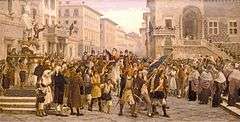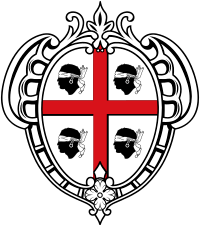Sa die de sa Sardigna
| Sardinia's Day Sa die de sa Sardigna | |
|---|---|
 G. Maria Angioy enters in Sassari (1795) | |
| Official name | Sa die de sa Sardigna |
| Also called |
Giornata del popolo sardo (Sardinian people's Day) |
| Observed by | Sardinia, Italy |
| Significance | Commemorates the Sardinian Vespers |
| Date | April 28 |
| Frequency | annual |
Sardinia's Day (Sa die de sa Sardigna in Sardinian language, La dì di la Sardigna in Sassarese, La dì di la Saldigna in Gallurese, lo dia de la Sardenya in Algherese, Il giorno della Sardegna in Italian), also known as Sardinian people's Day (Giornata del popolo sardo), is a holiday in Sardinia commemorating the Sardinian Vespers occurring in 1794–1796.
History
In the last decades of the XVIII° century following the Savoyard take-over of the island and the once Spanish Kingdom, discontent began to grow among the Sardinians towards the Piedmontese administration.[1][2] Sardinian peasants resented the feudal rule and both the local nobles and the bourgeoisie were being left out of any active civil and military role, with the viceroy and other people from the Italian Mainland being appointed in charge of the island. Such political unrest was bolstered further by the international situation, with particular regard to the ferment developing in other European regions (namely Ireland, Poland, Belgium, Hungary, Tyrol) and the episodes leading to the French revolution.
In 1793, a French fleet tried to conquer the island along two lines of attack, the first one across the Southern coast in Cagliari[3] and the other, led by the young Lieutenant Colonel Napoleon Bonaparte,[4] in the nearby of the Maddalena archipelago. However, the locals managed to resist the invasion by the French, and began expecting the Savoyards to acknowledge the feat and improve their condition in return. The Sardinians thus demanded most of the offices be reserved for them, along with autonomy from the Savoyard ruling class.[5]
The King's peremptory refusal to grant the island any of these wishes[6] eventually spurred the rebellion, with the arrest of two notable figures of the so-called "Patriotic Party" (the lawyers from Cagliari Vincenzo Cabras and Efisio Pintor) being the final spark of unrest amongst the populace. On 28 April 1794, known as sa dii de s'aciappa[7] (standing for "the day of the pursuit and capture"), people in Cagliari started chasing any Piedmontese functionaries they could find; since many of them started to wear the local robes in order to blend into the crowd, any people suspected to be from the Italian mainland would be asked by the populace to "say cheackpea" (nara cixiri) in Sardinian: failure in pronouncing the word correctly would give their origin away. By May, all the 514 Savoyard officers were put on a boat and sent back to the Mainland. Encouraged by what happened in Cagliari, the revolt spread throughout the island in the countryside as well and people in Alghero and Sassari did the same. The uprising was then led for another two years by the republican Giovanni Maria Angioy, then a judge of the Royal Hearing (Reale Udienza), but it was later repressed by the loyalist forces that became bolstered by the peace treaty between France and Piedmont in 1796. The revolutionary experiment was thus brought to an end and Sardinia remained under Savoy rule.[8][9]
Institutionalization of the date
The actual date was chosen in 1993[10] and public events are being annually held to commemorate the episode, while the schools are closed.
See also
- Giovanni Maria Angioy
- Su patriottu sardu a sos feudatarios, revolutionary Sardinian anthem
- History of Sardinia
- Sardinia
Notes
- ↑ <<The resentment of the Sardinian Nation towards the Piedmontese had been growing for more than half a century, when they [Piedmontese] began to keep for themselves all the lucrative employments on the island, to violate the ancient privileges granted to the Sardinians by the Kings of Aragon, to promote to the highest positions people of their own kind while leaving to the Sardinians only the episcopates of Ales, Bosa and Castelsardo, that is Ampurias. The arrongance and scorn with which the Piedmontese had been treating the Sardinians by calling them bums, dirty, cowards and other similar and irritating names, and above all the most common expression of Sardi molenti, that is "Sardinian donkeys", did little but worsen their disposition as the days passed, and gradually alienated them from this nation.>> Tommaso Napoli, Relazione ragionata della sollevazione di Cagliari e del Regno di Sardegna contro i Piemontesi
- ↑ <<The hostility against the Piedmontese was no longer a matter of employments, like the last period of Spanish rule, the dispatches of the viceroy Balbiano and the demands of the Stamenti may paint it out to be. The Sardinians wanted to get rid of them not only because they stood as a symbol of an anachronistic dominion, hostile to both the autonomy and the progress of the island, but also and perhaps especially because their presumptuosness and intrusiveness had already become insufferable.>> Raimondo Carta Raspi, Storia della Sardegna, Editore Mursia, Milano, 1971, pp.793
- ↑ Tommaso Napoli, Relazione di quanto è avvenuto dalla comparsa della flotta francese in Cagliari sino alla totale ritirata di essa nel 1793/94
- ↑ La Maddalena, 22/25 February 1793, Military Subjects
- ↑ Concerning the colonial-like (Girolamo Sotgiu, Storia della Sardegna sabauda, Editore La Terza, Roma-Bari, 1984, pp.76) relation of formal as well as substantial dependence of the local viceroy from the central power in the Mainland: <<The instructions did not draw a general direction of government policy to be observed in the island's affairs, but instead set, with meticulous pedantry, a number of duties that made the viceroy a bureaucratic executor of orders who was denied any possibility of self-initiative. Therefore, the viceroy did not have any political role to fulfill, but just beaurocratic obligations to perform. All the power was in fact concentrated in Turin and the viceroy was a mere missus dominici, who was not allowed to go beyond rather rigid instructions. As to make the viceroy's position even less effective, the viceroy's prerogatives had been weakened even more than under Spanish rule, although it was not given public notice of such a fact, out of prudence.>> Girolamo Sotgiu, Storia della Sardegna sabauda, Editore La Terza, Roma-Bari, 1984, pp.25
- ↑ <<The meaning was clear: more than a humiliation to the members of the Stamenti, it ought to be considered a warning to the Sardinians, who were not allowed to ask more than what they received from the king: that is, nothing at all.>> Raimondo Carta Raspi, Storia della Sardegna, Editore Mursia, Milano, 1971, pp.793
- ↑ Sa dì de s´acciappa - Dramma storico in due tempi e sette quadri, Piero Marcialis, 1996, Condaghes
- ↑ De La Calle, Luis (2015). Nationalist violence in postware Europe, pp.188, Cambridge
- ↑ Gabriele, Nicola (translated by Sally Davies), 2014. A History of Sardinia, University of Cagliari
- ↑ Legge Regionale 14 settembre 1993, n. 44
References
- Anonymous author (presumably Michele Obino). L'Achille della sarda liberazione, 1796.
- Lorenzo del Piano, Salvatore Frassu e i moti rivoluzionari della fine del '700 a Bono, Chiarella, 1989.
- Alberto Loni e Giuliano Carta. Sa die de sa Sardigna – Storia di una giornata gloriosa. Sassari, Isola editrice, 2003.
- Girolamo Sotgiu. L'insurrezione di Cagliari del 28 aprile 1794, Agorà, 2005.
- Massimo Pistis, Rivoluzionari in sottana. Ales sotto il vescovado di mons. Michele Aymerich, Roma, Albatros Il Filo, 2009.
- Adriano Bomboi, L'indipendentismo sardo. Le ragioni, la storia, i protagonisti, Cagliari, Condaghes, 2014.
